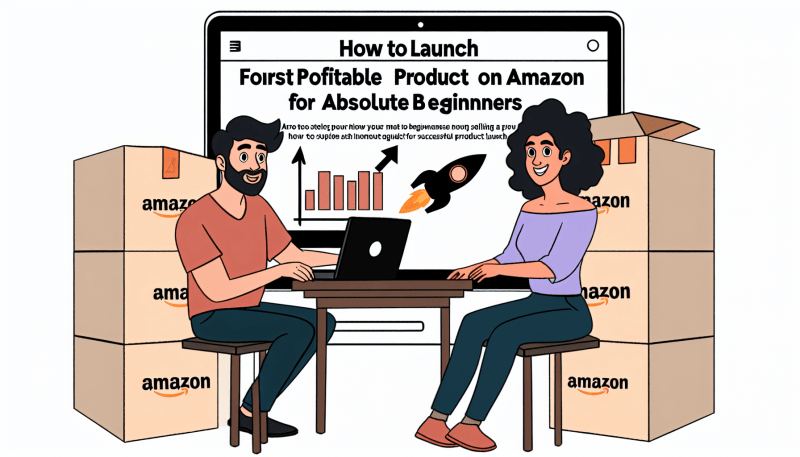How to Launch Your First Profitable Product on Amazon: A Step-by-Step Guide for Absolute Beginners
Launching your first product on Amazon can seem like a daunting task, especially for absolute beginners. However, with the right strategy and guidance, you can embark on a journey towards establishing a profitable presence on one of the world's largest online marketplaces. This step-by-step guide is designed to help you navigate through the process, from product selection to making your first sale.
Step 1: Conduct In-depth Market Research
To kickstart your Amazon selling journey, the first critical step is conducting in-depth market research. This involves identifying a niche with high demand but relatively low competition. Tools like Jungle Scout, Helium 10, or Amazon's own Best Sellers list can provide valuable insights into market trends, keyword popularity, and competitor analysis.
Remember, choosing the right product is half the battle. Focus on items that solve specific problems, cater to untapped niches, or offer significant improvements over existing solutions. The goal is to find a product that resonates with a specific audience, giving you a competitive edge.
Step 2: Find a Reliable Supplier
Once you have a product idea in mind, the next step is to find a reliable supplier. Platforms like Alibaba and Global Sources are great places to start your search. When selecting a supplier, consider the quality of their products, production capacity, shipping times, and communication efficiency.
It's crucial to order samples before committing to a large inventory. This allows you to assess the product quality firsthand and ensure it meets your expectations. Additionally, solidify your relationship with the supplier through clear communication and understanding their production and delivery schedules.
Step 3: Create Your Amazon Seller Account
With your product and supplier lined up, it's time to create your Amazon Seller Account. Go to Amazon Seller Central and choose between an Individual or Professional account. For most beginners, a Professional account is recommended due to its access to advanced selling tools, despite the monthly fee.
During the signup process, you'll be required to provide detailed information about your business, including tax details and bank information. Ensure all the provided information is accurate to avoid any delays in account activation.
Step 4: Craft Compelling Product Listings
Your product listings are the window through which potential customers view your offerings. A compelling listing combines an attention-grabbing title, high-quality images, detailed and keyword-rich descriptions, and competitive pricing.
Use high-resolution images that showcase your product from multiple angles. For the product title and description, incorporate relevant keywords to improve your search visibility on Amazon. Also, highlight the unique benefits and features of your product to differentiate it from competitors. Finally, pricing should be competitive yet profitable, taking into account costs like Amazon fees, production, and shipping.
Step 5: Implement an Effective Launch Strategy
Launching your product effectively is crucial for gaining initial traction and visibility. A popular strategy is using Amazon's PPC (Pay-Per-Click) advertising to increase your product's visibility. Start with a small budget, focusing on high-converting keywords, and gradually adjust based on performance.
Additionally, consider running promotions or discounts to encourage initial sales. This not only boosts your product ranking but also starts the flow of customer reviews. Remember, positive reviews can significantly influence potential buyers and improve your product's credibility and visibility.
Step 6: Optimize Your Operations for Efficiency
As your Amazon business grows, optimizing your operations becomes crucial. Utilize Amazon's Fulfillment by Amazon (FBA) service to handle shipping and customer service. This not only saves you time but also enhances the customer experience with faster delivery times and Amazon Prime eligibility.
Additionally, keep a close eye on your inventory levels to avoid stockouts or overstocking, both of which can negatively impact your profitability. Use Amazon's inventory management tools or external software to help forecast demand and plan your inventory accordingly.
Launching a profitable product on Amazon requires careful planning, research, and execution. By following these steps, you can increase your chances of success in the competitive online marketplace. Remember, persistence and continuous improvement are key to growing your Amazon business over time.
Launching Your Initial Profitable Amazon Product: An Absolute Beginner's Step-by-Step Tutorial
For those new to the eCommerce space, initiating your first product sale on Amazon can appear overwhelming. Yet, with the correct approach and insightful guidance, you can start a successful journey in one of the globe's most expansive online retail arenas. This comprehensive guide aims to walk you through each phase of the process, from selecting the perfect product to celebrate your first sale.
Step 1: Deep Dive into Market Analysis
The journey to a successful Amazon venture begins with thorough market research. It's about discovering a niche that not only has a high demand but also faces minimal competition. Utilize tools such as Jungle Scout, Helium 10, or the Amazon Best Sellers lists to gain a deeper understanding of market dynamics, keyword efficacy, and what your competitors are doing.
Finding a product that stands out because it addresses specific issues, targets underrepresented niches, or significantly improves on current market offerings can give you a unique advantage. Aim for a product that connects on a personal level with your desired demographic to establish your competitive edge.
Step 2: Securing a Dependable Supplier
Having zeroed in on a potential product, the ensuing step revolves around finding a dependable supplier. Begin your search with platforms such as Alibaba or Global Sources. It's essential to evaluate suppliers based on the quality of their merchandise, their ability to produce at scale, timeliness of delivery, and ease of communication.
Prior to a bulk order, insist on sample products to personally verify quality and ensure it meets your standards and expectations. Building a strong rapport with your supplier, through clear and consistent communication, will help in understanding their production capabilities and timelines.
Step 3: Setting Up Your Amazon Seller Profile
With a product and supplier in place, the next logical step is to set up your Amazon Seller account. Navigate to Amazon Seller Central to decide between the Individual or Professional account options. Despite the monthly fee, the Professional account is generally recommended for beginners for its access to advanced selling tools and functionalities.
The signup process will require you to furnish detailed business information, including tax identification and banking details. Accuracy at this stage is crucial to avoid any hindrance in account activation.
Step 4: Crafting Your Product Listings
A successful listing is your gateway to attracting potential customers. It should feature a catchy title, high-definition images, detailed descriptions imbued with relevant keywords, and competitive pricing.
Ensure the images are of high quality, showcasing your product from various angles to give customers a comprehensive view. In your title and description, strategically include relevant keywords to boost your visibility in search results on Amazon. Emphasize the distinctive benefits and features that set your product apart from the competition. Lastly, ensure your pricing strategy is both competitive and lucrative, factoring in Amazon fees, and production and shipping costs.
Step 5: Effective Product Launch Tactics
An effective product launch can significantly amplify your product's initial visibility and sales momentum. Consider leveraging Amazon's Pay-Per-Click (PPC) advertisements to heighten your product's online presence. Begin with a modest budget, concentrating on keywords with high conversion potential, and iteratively refine your strategy based on performance analytics.
Incorporating promotions or discounts at the outset can foster initial sales spikes, thereby elevating your product rankings and fostering early reviews. Keep in mind, positive customer feedback greatly influences prospective buyers and enhances your product's reputation and discoverability.
Step 6: Enhance Your Operations for Maximum Efficiency
As your Amazon enterprise flourishes, operational efficiency becomes paramount. Engaging with Amazon's Fulfillment by Amazon (FBA) program can be a game-changer, taking the burden of shipping and customer service off your shoulders, enabling faster deliveries, and qualifying your products for Amazon Prime.
Maintaining optimal inventory levels is also critical to avert either stockouts or excessive stocking, both detrimental to your profit margins. Utilize Amazon's inventory tools or third-party applications to accurately forecast demand and manage stock levels efficiently.
Embarking on a profitable Amazon selling journey demands meticulous planning, thorough research, and strategic execution. By adhering to these step-by-step instructions, you're well on your way to carving out a successful niche in the competitive e-commerce landscape. Remember, perseverance and ongoing refinement are your allies in scaling your Amazon operations.






